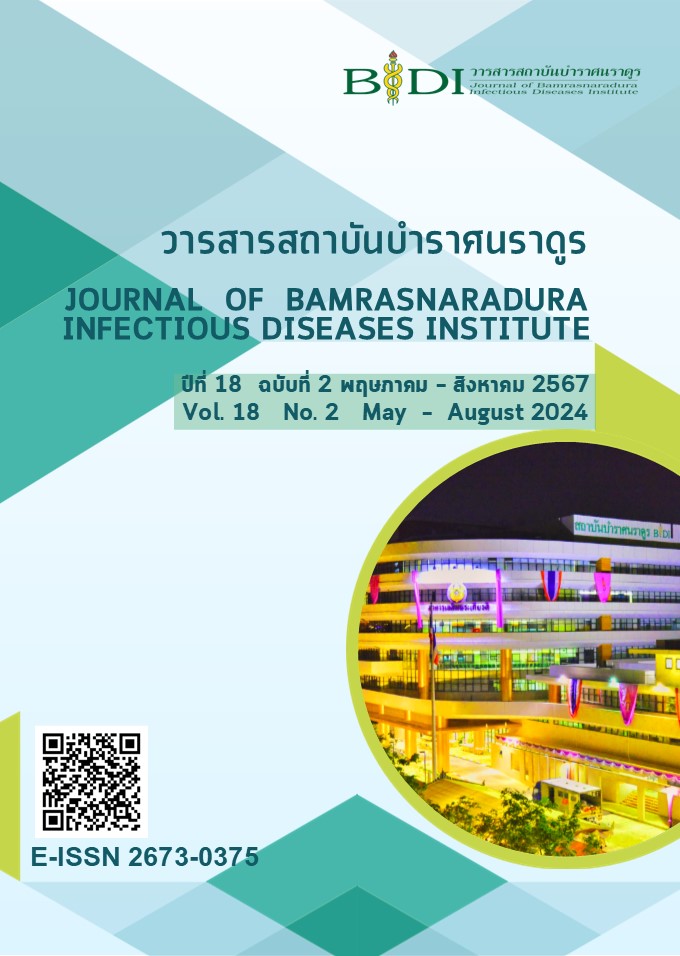ผลของสื่อวีดิทัศน์เรื่องการป้องกันการแพร่กระจายเชื้อทางการสัมผัส ต่อความรู้และการปฏิบัติของผู้ดูแลผู้ป่วย โรงพยาบาลกรุงเทพเชียงใหม่
Main Article Content
บทคัดย่อ
โรคที่สามารถแพร่กระจายเชื้อทางการสัมผัสหลายชนิดสามารถติดต่อได้รวดเร็ว เกิดการแพร่กระจายไปสู่ครอบครัวและคนรอบข้างได้ง่าย การให้ความรู้ที่ถูกต้องเกี่ยวกับการปฏิบัติในการป้องกันการแพร่กระจายเชื้อแก่ผู้ดูแลผู้ป่วยจึงเป็นสิ่งสำคัญ การวิจัยครั้งนี้เป็นการวิจัยเชิงทดลองแบบสองกลุ่มวัดก่อนและหลังการทดลอง มีวัตถุประสงค์เพื่อศึกษาผลของสื่อวีดิทัศน์เรื่องการป้องกันการแพร่กระจายเชื้อทางการสัมผัสต่อความรู้และการปฏิบัติของผู้ดูแลผู้ป่วย กลุ่มตัวอย่างคือผู้ที่กำลังดูแลผู้ป่วยที่ได้รับการวินิจฉัยด้วยโรคที่แพร่กระจายเชื้อทางการสัมผัสในโรงพยาบาลกรุงเทพเชียงใหม่ ระหว่างเดือนตุลาคมถึงเดือนพฤศจิกายน 2563 จำนวน 46 ราย คัดเลือกเข้าร่วมการวิจัยตามหลักเกณฑ์ที่กำหนด แบ่งเป็นกลุ่มทดลองและกลุ่มควบคุม กลุ่มละ 23 ราย กลุ่มทดลองได้รับความรู้จากการชมสื่อวีดิทัศน์ กลุ่มควบคุมได้รับความรู้ด้วยวิธีปกติตามมาตรฐานของโรงพยาบาล เครื่องมือที่ใช้ในการวิจัย ได้แก่ สื่อวีดิทัศน์เรื่องการป้องกันการแพร่กระจายเชื้อทางการสัมผัส แบบสอบถามข้อมูลส่วนบุคคล แบบวัดความรู้เกี่ยวกับการป้องกันการแพร่กระจายเชื้อทางการสัมผัส และแบบบันทึกการสังเกต โดยมีค่าความเชื่อมั่นสัมประสิทธิ์แอลฟาครอนบาค เท่ากับ 0.85 วิเคราะห์ข้อมูลด้วยสถิติพรรณนา Independent t-test และ Paired t-test
ผลการวิจัยพบว่าผู้ดูแลผู้ป่วยกลุ่มทดลองที่ได้รับข้อมูลโดยชมสื่อวีดิทัศน์มีความรู้เกี่ยวกับการป้องกันการแพร่กระจายเชื้อทางการสัมผัสสูงกว่าผู้ดูแลผู้ป่วยกลุ่มควบคุมอย่างมีนัยสำคัญทางสถิติ (p < 0.001) และมีคะแนนการปฏิบัติในการป้องกันการแพร่กระจายเชื้อทางการสัมผัสสูงกว่ากลุ่มควบคุมอย่างมีนัยสำคัญทางสถิติ (p < 0.05)
ผลการวิจัยครั้งนี้แสดงให้เห็นว่า การให้ข้อมูลโดยใช้สื่อวิดีทัศน์ส่งผลให้ผู้ดูแลผู้ป่วยมีความรู้และการปฏิบัติในการป้องกันการแพร่กระจายเชื้อทางการสัมผัสถูกต้องเพิ่มขึ้น สามารถนำไปใช้เพื่อส่งเสริมความรู้และการปฏิบัติที่ถูกต้องแก่ผู้ดูแลผู้ป่วยและญาติได้
Article Details
References
Centers for Disease Control and Prevention. 2007 Guideline for Isolation Precautions: Preventing Transmission of Infectious Agents in Healthcare Settings [internet] 2019. [cited 2021 Oct 5]. Available from: https://www.cdc.gov/infectioncontrol/pdf/guidelines/isolation-guidelines-H.pdf
Medical Records and Statistics Bangkok Hospital Chiang Mai. Hospital Patient Statistics Report Chiang Mai from 2017 to 2019. Medical Records Audit Bangkok Hospital Chiang Mai; 2019. (in Thai)
Tapin P, Boonchieng W, Suttajit S. Parental health literacy and behavior to prevent hand-foot-and-mouth disease in child development center of Charoen Mueang sub-district, Chiang Rai. Lampang Med J 2018; 39(2): 72-80.
Promsopan C, Prabpai S. Factors related to hand foot and mouth disease prevention behaviors among parents and preschool children in amphoe Bua Yai, Nakhon Ratchasima province. Dis Control J 2017; 43(4): 356-67.
Knowles MS, Holton EF, Swanson RA. Adult learner: the definitive classic in adult education and human resource development. 6th ed. Boston: Elsebier; 2005.
Utamachun W. Television and computer media production. 2nd ed. Bangkok: OS Printing House; 2001.
Ketphak N. Effects of information provision using video media on patients’ knowledge and practices in prevention of nosocomial infection [dissertation]. Chiang Mai: Chiang Mai University; 2011. (in Thai)
Otcharoenchai S. Effects of information provision using video media on housekeepers’ knowledge and practices in infectious waste management in community hospital [dissertation]. Chiang Mai: Chiang Mai University; 2010. (in Thai)
Kongtan A. Effects of information provision using video media on professional nurses’ knowledge and practices in prevention of intravenous infusion related infections [dissertation]. Chiang Mai: Chiang Mai University; 2010. (in Thai)
Kala S, Youngwanichsate S, Chunuan S. Effects of instructional videos on the knowledge and labour practical skills of nursing students. Songkla Med J. 2008; 26(2): 111-21.
Burns N, Grove SK. The Practice of nursing research: conduct, critique, and utilization. 5th ed. St. Louis Missouri: Elsevier saunders; 2005.
Lopez EJ. The Art of Using Visual Aids. In: Lopez EJ, editors. The 2005 sourcebook for advance practice nurses. Philadelphia: Lippincott Williams & Wilkins; 2005. P.15-16.
Khaosriprai S. Instructional media: basic principle and theory to practice. BangKok: Srinakharinwirot University; 2006. (in Thai)
Romkaew N. Introduction to Educational Technology Research. Chiang Mai: Chiang Mai Rajabhat University; 2004. (in Thai)
Noinam S, Kittipimpanon K, Kraithaworn P, Tongvichean T. The effectiveness of video media about diabetic foot assessment on knowledge, self-confidence, and satisfaction of nursing students. Bangkok: Mahidol University; 2021. (in Thai)
El Sayad R, El Raouf S. Video-based lectures: an emerging paradigm for teaching human anatomy and physiology to student nurses. Alexandria J Med. 2013; 49(3): 215-22.
Rachakul C, Suvannit C, Tuangratananon T. Survey of public perspectives toward population adherence to COVID-19 mitigation policy following the outbreak in the first half of 2021. Nonthaburi: Health Systems Research Institute; 2021. (in Thai)
Kaewpradit E. Educational Technology: Principles and Ideas to Practice. Songkhla: Thaksin University. (in Thai)
Khamanee T. Knowledge for effective organization of learning processes. 4th ed. Bangkok: Dan Suttha Printing; 2005. (in Thai)
Chuang YH, Lai FC, Chang CC, Wan HT. Effects of a skill demonstration video delivered by smartphone on facilitating nursing students’ skill competencies and self-confidence: a randomized controlled trial study. Nurse Educ Today. 2018; 66: 63-8.
Scherer LA, Chang MC, Meredith JM, Battistella FD. Videotape review leads to rapid and sustained learning. AJS 2003; 185(6): 516-20.

